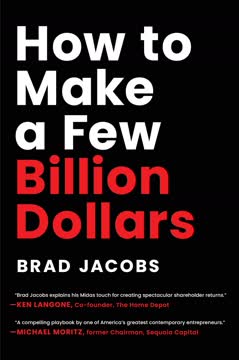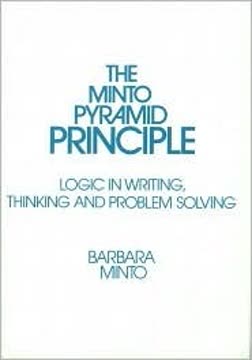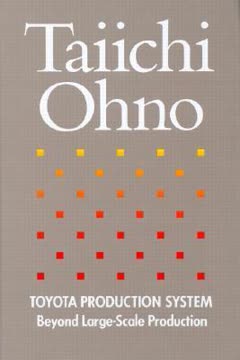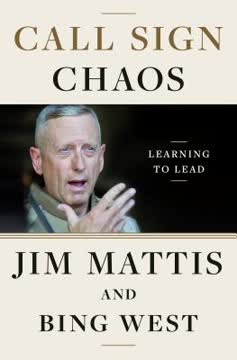Key Takeaways
1. Lean production revolutionizes manufacturing, surpassing mass production
Lean production is a superior way for humans to make things.
Paradigm shift. Lean production represents a fundamental shift in manufacturing philosophy, combining the best aspects of craft production and mass production. It reduces costs, improves quality, and offers greater product variety compared to traditional mass production methods.
Historical context. The concept emerged in Japan after World War II, primarily developed by Toyota. It addresses the limitations of mass production, which dominated manufacturing since Henry Ford's time. Lean production's superiority is evident in:
- Higher productivity: Lean manufacturers require less human effort to produce a given quantity of goods
- Improved quality: Fewer defects and more consistent output
- Increased flexibility: Ability to produce a wider range of products with the same equipment
- Reduced inventory: Just-in-time production minimizes storage needs
- Enhanced worker satisfaction: Greater involvement and problem-solving opportunities
2. Toyota pioneers lean production, emphasizing efficiency and quality
Toyota spun its in-house supply operations off into quasi-independent first-tier supplier companies in which Toyota retained a fraction of the equity and developed similar relationships with other suppliers who had been completely independent.
Toyota Production System. Toyota's approach to manufacturing, developed by Taiichi Ohno and others, forms the foundation of lean production. Key elements include:
- Elimination of waste (muda) in all forms
- Continuous flow of production
- Pull system for inventory management
- Standardization of best practices
- Built-in quality control
Supplier relationships. Toyota revolutionized supplier management by:
- Creating a tiered supplier system
- Fostering long-term partnerships based on mutual benefits
- Encouraging suppliers to innovate and improve their processes
- Sharing knowledge and best practices throughout the supply chain
This approach contrasts sharply with the adversarial relationships often found in mass production systems, leading to improved quality, reduced costs, and faster innovation cycles.
3. Lean production minimizes waste and maximizes value creation
The fundamental ideas of lean production are universal—applicable anywhere by anyone—and that many non-Japanese companies have already learned this.
Waste elimination. Lean production identifies and eliminates eight types of waste:
- Overproduction
- Waiting
- Transportation
- Over-processing
- Inventory
- Motion
- Defects
- Unused employee creativity
Value creation. By focusing on customer needs and eliminating non-value-adding activities, lean production increases overall efficiency and effectiveness. This approach:
- Reduces lead times
- Improves product quality
- Lowers production costs
- Increases customer satisfaction
- Enhances employee engagement
The universality of these principles means that lean production can be applied across industries and cultures, though implementation may vary based on specific contexts.
4. Just-in-time system transforms supply chain management
Ohno's idea was simply to convert a vast group of suppliers and parts plants into one large machine, like Henry Ford's Highland Park plant, by dictating that parts would only be produced at each previous step to supply the immediate demand of the next step.
Synchronized production. The just-in-time (JIT) system revolutionizes inventory management and production scheduling by:
- Producing only what is needed, when it's needed, and in the amount needed
- Reducing inventory levels and associated costs
- Improving cash flow and reducing working capital requirements
Kanban system. Toyota's method for implementing JIT uses visual signals (kanban) to trigger production and movement of materials:
- Ensures smooth flow of materials through the production process
- Prevents overproduction and minimizes inventory buildup
- Quickly identifies bottlenecks and quality issues
JIT requires close coordination with suppliers and a stable production environment to function effectively. When implemented successfully, it dramatically reduces waste and improves overall efficiency.
5. Continuous improvement and problem-solving drive lean production
Toyota always can trace every defective part to its ultimate cause and to ensure that a solution is devised that prevents this error from ever happening again.
Kaizen culture. Continuous improvement is a cornerstone of lean production, fostering a culture where all employees are engaged in identifying and implementing improvements:
- Regular small improvements accumulate into significant gains over time
- Empowers workers at all levels to contribute ideas
- Creates a dynamic and adaptive organization
Problem-solving techniques. Lean production employs systematic approaches to identify and address issues:
- Root cause analysis (e.g., "5 Whys" technique)
- Plan-Do-Check-Act (PDCA) cycle
- Visual management tools (e.g., Andon boards)
These methods ensure that problems are not just fixed temporarily but eliminated at their source, preventing recurrence and continuously improving the production system.
6. Lean product development accelerates innovation and reduces costs
Lean producers, on the other hand, set their sights explicitly on perfection: continually declining costs, zero defects, zero inventories, and endless product variety.
Efficient design process. Lean product development streamlines the innovation process by:
- Involving cross-functional teams from the start
- Using set-based concurrent engineering to explore multiple design options simultaneously
- Emphasizing early problem-solving to reduce costly late-stage changes
Rapid prototyping and testing. Lean development accelerates the product cycle by:
- Creating quick, low-fidelity prototypes for early testing
- Incorporating customer feedback throughout the development process
- Using modular design principles to increase flexibility and reduce costs
This approach allows companies to bring new products to market faster, with lower development costs and better alignment with customer needs. It also enables more frequent product updates and a wider range of offerings.
7. Lean production reshapes workforce dynamics and management practices
In lean production, it is the dynamic work team that emerges as the heart of the lean factory.
Team-based organization. Lean production reorganizes work around multi-skilled teams:
- Workers are trained in multiple skills and rotate jobs
- Teams are responsible for quality, maintenance, and continuous improvement
- Flatter organizational structures with fewer management layers
Leadership and management. The role of managers shifts in lean organizations:
- Leaders become coaches and facilitators rather than just supervisors
- Decision-making is pushed down to the lowest appropriate level
- Managers focus on developing people and improving processes
This approach increases worker engagement, improves problem-solving capabilities, and creates a more flexible and adaptive organization. However, it also requires a significant shift in corporate culture and management practices.
8. Global diffusion of lean production faces cultural and organizational challenges
The great challenge of the current moment is to avoid making such an error twice.
Cultural barriers. Implementing lean production across different cultures presents challenges:
- Resistance to change from traditional mass production mindsets
- Differences in work ethics and team dynamics
- Varying levels of worker empowerment and initiative
Organizational obstacles. Existing structures and practices can hinder lean adoption:
- Rigid hierarchies and departmental silos
- Short-term financial focus conflicting with long-term lean investments
- Lack of leadership commitment and understanding
Successful global diffusion of lean production requires:
- Adapting lean principles to local contexts while maintaining core concepts
- Investing in extensive training and education at all levels
- Demonstrating clear benefits to gain buy-in from stakeholders
- Patience and persistence in driving cultural and organizational change
9. Lean production extends beyond manufacturing to service industries
Lean production calls for learning far more professional skills and applying these creatively in a team setting rather than in a rigid hierarchy.
Service sector applications. Lean principles are increasingly applied in non-manufacturing contexts:
- Healthcare: Improving patient flow, reducing wait times, enhancing quality of care
- Financial services: Streamlining processes, reducing errors, improving customer service
- Software development: Agile methodologies incorporate many lean concepts
Adaptations for services. Lean concepts are modified to fit service industry needs:
- Value stream mapping for information flows
- Standardization of best practices while maintaining flexibility for customer needs
- Applying pull systems to manage workload and capacity
The extension of lean principles to services demonstrates their universal applicability and potential to improve efficiency and quality across diverse industries.
10. The future of industry hinges on widespread adoption of lean principles
Lean production is fragile.
Competitive advantage. Companies that successfully implement lean production gain significant advantages:
- Higher productivity and quality
- Greater flexibility and responsiveness to market changes
- Improved innovation capabilities
- Enhanced customer satisfaction
Challenges to adoption. Despite its benefits, lean production faces obstacles to widespread adoption:
- Resistance from established mass production organizations
- Short-term financial pressures conflicting with long-term lean investments
- Difficulty in maintaining lean practices in volatile market conditions
The future of global industry will be shaped by how effectively companies can overcome these challenges and fully embrace lean principles. Those that succeed will likely dominate their industries, while those that fail to adapt may struggle to remain competitive.
Last updated:
FAQ
What's The Machine That Changed the World about?
- Focus on Lean Production: The book delves into lean production, a system developed by Toyota, which contrasts with traditional mass production by enhancing efficiency and quality while reducing waste.
- Historical Context: It provides a comprehensive history of the automotive industry, tracing the evolution from craft to mass to lean production, highlighting the significance of these shifts.
- Global Impact: Lean production's relevance extends beyond automotive, with applications in various sectors like healthcare and services, revolutionizing global industry practices.
Why should I read The Machine That Changed the World?
- Management Insights: Offers valuable insights into management and production efficiency, emphasizing teamwork and continuous improvement, applicable to any organization.
- Real-World Examples: Includes case studies from Toyota and others, illustrating practical applications of lean principles, making concepts relatable and understandable.
- Timeless Relevance: Despite its 1990 publication, the principles remain relevant, providing lessons applicable to modern business challenges.
What are the key takeaways of The Machine That Changed the World?
- Lean vs. Mass Production: Highlights lean production's superiority in efficiency, quality, and flexibility, reducing waste and improving responsiveness to customer needs.
- Five Elements of Lean: Outlines critical elements like product design, supply chain coordination, and enterprise management essential for successful lean implementation.
- Cultural Shift: Emphasizes the need for a cultural shift focusing on employee empowerment and continuous improvement to sustain lean practices.
What is lean production, as defined in The Machine That Changed the World?
- Definition of Lean Production: A system using less of everything compared to mass production, aiming for perfection with zero defects and continuous improvement.
- Key Characteristics: Emphasizes flexibility, teamwork, and waste elimination, encouraging workers to take responsibility and seek improvements.
- Comparison to Mass Production: Unlike mass production's focus on high volume, lean production offers product variety while maintaining quality and low costs.
How does The Machine That Changed the World compare lean production to mass production?
- Efficiency and Waste: Lean production is more efficient, reducing excess inventory and waste, streamlining processes, and eliminating unnecessary steps.
- Quality Control: Emphasizes quality at every stage, preventing defects proactively, unlike mass production's reliance on post-production inspection.
- Flexibility: Lean systems are more adaptable to changing customer demands, essential in today's fast-paced market environment.
What are the five elements of a lean business system mentioned in The Machine That Changed the World?
- Product Design: Focuses on manufacturability and simplicity, designing products that meet customer needs and are easy to manufacture.
- Supply Chain Coordination: Involves just-in-time delivery and minimizing inventory, fostering long-term supplier relationships based on mutual benefit.
- Customer Relations: Emphasizes understanding customer needs and involving them in product development, building long-term relationships.
- Production Processes: Designed to minimize waste and maximize efficiency, using techniques like value stream mapping to eliminate non-value-added activities.
- Enterprise Management: Aligns all departments towards common goals of efficiency and quality, managing the enterprise as a cohesive unit.
What challenges do organizations face when transitioning to lean production, according to The Machine That Changed the World?
- Resistance to Change: Employees may resist changes due to fear of job loss or increased pressure, requiring strategies to overcome this resistance.
- Need for Training: Organizations must invest in training employees on lean principles, essential for building necessary skills in a lean environment.
- Cultural Barriers: Existing company cultures may not align with lean principles, necessitating a shift towards valuing teamwork, empowerment, and continuous improvement.
How does The Machine That Changed the World illustrate the differences between mass production and lean production?
- Historical Examples: Compares Ford and GM's practices with Toyota's, showing how lean production addresses inefficiencies and quality issues of mass production.
- Case Studies: Examples like the NUMMI plant demonstrate successful lean implementation in traditional mass-production environments, highlighting practical benefits.
- Performance Metrics: Uses metrics to show differences in productivity and quality, with lean plants like Toyota's Takaoka being more productive and having lower defect rates.
What role does customer feedback play in lean production, as discussed in The Machine That Changed the World?
- Direct Link to Production: Establishes a direct connection between customer feedback and production, allowing quick responses to changing preferences.
- Continuous Improvement: Integral to identifying areas for enhancement, informing product development to better meet market demands.
- Building Relationships: Prioritizes customer needs, ensuring products are tailored to preferences, fostering stronger customer relationships.
What is the significance of the Toyota Production System (TPS) in The Machine That Changed the World?
- Foundation of Lean Production: TPS is the foundational model for lean production, emphasizing waste reduction, continuous improvement, and respect for people.
- Global Influence: TPS has inspired global manufacturing practices, leading to broader recognition of lean production benefits beyond automotive.
- Cultural Integration: TPS integrates employees at all levels into the production process, crucial for successful lean practice implementation.
How does The Machine That Changed the World address the global diffusion of lean production?
- Global Adoption: Discusses lean production's spread beyond Japan to other countries and industries, driven by the need for efficiency and competitiveness.
- Case Studies of Implementation: Examples from North America and Europe illustrate challenges and successes in adopting lean practices in different contexts.
- Future Implications: Suggests lean production's continued spread will profoundly affect global manufacturing and economies, emphasizing adaptation for future success.
What are the best quotes from The Machine That Changed the World and what do they mean?
- "The machine that is changing the world is this complete lean business system.": Emphasizes lean production as a holistic system transforming business operations, highlighting interconnectedness.
- "Lean production is a system that uses less of everything compared to mass production.": Captures lean production's essence, focusing on efficiency and waste reduction, achieving more with less.
- "The quest for perfection continues to generate surprising twists.": Reflects ongoing improvement in lean production, suggesting innovation and better practices arise from pursuing perfection.
Review Summary
The Machine That Changed the World is praised as a landmark study of lean manufacturing in the automotive industry. Readers appreciate its historical context and insights into production methods, though some find it dense and dated. The book compares craft, mass, and lean production, highlighting Toyota's innovations. While focused on cars, many find its principles broadly applicable. Some criticize its bias toward Japanese methods. Overall, it's considered an important work for understanding lean principles, despite its age.
Similar Books









Download PDF
Download EPUB
.epub digital book format is ideal for reading ebooks on phones, tablets, and e-readers.






